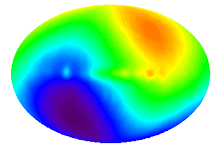Are viruses our oldest
ancestors?
Humans have a skewed
view of viruses because we only notice them if they cause disease. In reality,
however, viruses are much more than pathogens. HIV and influenza cause
frightening health threats, but 1019 HIV particles worldwide are
basically nothing compared to 1033 total number of viruses on our
planet. Viruses are present in every species and every ecological niche, and
affect every organism. They even influence the global climate by regulating the
population densities of microorganisms—and thereby nutrient availability—in the
oceans.
Bacteriophages are the
most successful entities on our planet as judged by their abundance, their
efficiency in replication and gene transfer and their ability to adapt. Almost
all phages have replaced RNA with double-stranded DNA genomes; they are the
front-runners in evolution, whereas RNA plant viruses seem to be the
laggards—this could be explained with the vastly different replication rates of
their hosts. It might also explain why cut-and-paste DNA transposition is
active only in plants; in mammalian genomes, it terminated about 35 million
years ago and jumping retroelements increased genome size and diversity.
EMBO reports (2012) 13, 1033
Marine viruses
major players in the global ecosystem
Viruses are by far the
most abundant 'lifeforms' in the oceans and are the reservoir of most of the
genetic diversity in the sea. The estimated 10*30 viruses in the ocean, if
stretched end to end, would span farther than the nearest 60 galaxies. Every
second, approximately 10*23 viral infections occur in the ocean. These
infections are a major source of mortality, and cause disease in a range of
organisms, from shrimp to whales. As a result, viruses influence the
composition of marine communities and are a major force behind biogeochemical
cycles. Each infection has the potential to introduce new genetic information
into an organism or progeny virus, thereby driving the evolution of both host
and viral assemblages. Probing this vast reservoir of genetic and biological
diversity continues to yield exciting discoveries.
Nature Reviews
Microbiology 5, 801–812 (1 October 2007)
Infectious History
We should think of
each host and its parasites as a superorganism with the respective genomes
yoked into a chimera of sorts. The power of this sociological development could
not be more persuasively illustrated than by the case of mitochondria, the most
successful of all microbes. They reside inside every eukaryote cell (from yeast
to protozoa to multicellular organisms), in which they provide the machinery of
oxidative metabolism. Other bacteria have taken similar routes into plant cells
and evolved there into chloroplasts—the primary harvesters of solar energy,
which drive the production of oxygen and the fixed carbon that nourishes the
rest of the biosphere.
Science 14 April 2000: Vol. 288 no. 5464 pp. 287-293

沒有留言:
張貼留言